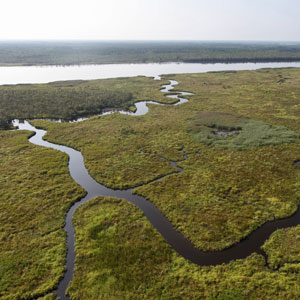
From New York to North Carolina, tidal rivers contain thousands of miles of habitat for fishing, crabbing, and other recreational activities.
Running through the Mid Atlantic are the Hudson, Raritan, Delaware, Susquehanna, Patapsco, Potomac, Patuxent, Rappahannock, York, James, Roanoke, Neuse, Cape Fear, and many others.
Fish Species
Tidal rivers contain a unique mix of freshwater, saltwater, and anadromous fish species. A few fish species occur in tidal rivers throughout the Mid Atlantic while others are limited in range.
Freshwater fish species are abundant in the upper stretches of most tidal rivers. Freshwater species include black bass, crappie, sunfish, yellow perch, chain pickerel, carp, catfish, gar, northern snakeheads, and many others.
Each spring, shad and river herring ascend Mid Atlantic tidal rivers to spawn. Shad are extremely popular with anglers. Most shad fishing occurs in moderate to fast moving water above river fall lines.
The striped bass, a top gamefish, is found in every major Mid Atlantic tidal river. The white perch is another important fish that occurs in tidal rivers and creeks.
From late spring thru fall, saltwater fish move up and down tidal rivers. Southern rivers often see runs of spot, croakers, kingfish, speckled trout, flounder, red drum, black drum, and others. Northern rivers are visited by striped bass, bluefish, summer flounder (fluke), weakfish, and many of the same species that are common in southern watersheds.
Fishing Areas
Tidal rivers contain an incredible range of habitats where fish feed, spawn, and grow. In many rivers, conditions change considerably over short stretches of water.
Tidal rivers contain a wide array of fish attracting structure including rocks, tree trunks and stumps, submerged aquatic vegetation, sandbars, shellfish beds, and deepwater areas.
Most rivers include sections that meander in a series of sharp bends. These areas tend to contain deep pools, shallow edges, rips, swirls, and other features.
Areas where waters converge can offer excellent opportunities for anglers. When small tributaries enter main channels, sharp breaks in water temperature and clarity often occur. Similar conditions are found at dam tailwaters or other outflows.
Along many tidal rivers, points can be productive areas to fish. Points that lie along open shorelines are usually bordered by drop offs. These areas often contain tide rips, sandbars, submerged aquatic vegetation, and other fish attracting features.
Tides and Currents
Tides create a complex system of water flow, fish movement, food distribution, and mixing, all of which can have major impacts on fishing.
During incoming tides, shallow areas are flooded with brackish water. When tides ebb, waters recede into main channels, bringing with it baitfish and other food sources.
An especially productive environment often occurs when a tributary enters a tidal river at an angle. Along these ‘super points,’ strong rips may form during tidal flows as water is forced to make a sharp turn of more than 90 degrees.